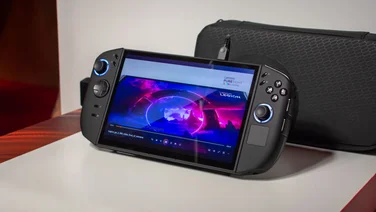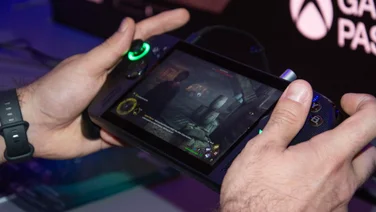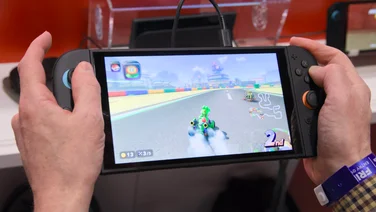To help us provide you with free impartial advice, we may earn a commission if you buy through links on our site. Learn more





- Comfortable design with chunky grips
- Precise and reliable Hall Effect sticks
- Works fuss-free with streaming services and Android/iOS games
- Fiddly touchscreen mapping required for certain games
- Limited customisation through the Gamesir app
The Gamesir Galileo G8 is a great example of how manufacturers have changed their approach to handheld gaming accessories following the release of the Steam Deck.
Before Valve’s portable console came to market, it was all about Nintendo, with most handhelds and smartphone controllers aping the design of the Nintendo Switch . Post-Steam Deck, many brands are embracing a more chunky, console controller design; one that’s more comfortable to hold over longer periods and has more room for analogue triggers and bumpers, not to mention proper analogue sticks.
Where previous Gamesir phone controllers like the X2 and X2 Pro mimicked the Switch design through a split controller with an extending back, the Galileo G8 has more in common with an Xbox gamepad . Its got big Hall Effect thumbsticks, massive grips and triggers and bumpers that haven’t been scaled down for portability. The result is the most comfortable and effective smartphone controller I’ve ever used, transforming any big-screen smartphone with a USB-C connector into a gaming handheld in a jiffy.
Gamesir Galileo G8 review: What do you get for your money?
One smartphone controller with a familiar Xbox layout. It has one thumbstick sitting above the D-Pad on the left and the other sitting lower, beneath the face buttons on the right. The ABXY face buttons follow the Xbox pattern rather than the Switch; the Xbox feel is bolstered by the chunky dual triggers and L1 and R1 bumpers at the rear.On the base of the controller, built into the grips, you’ll find two customisable L4 and R4 buttons, which you can assign to mirror the function of any two of the standard inputs. Meanwhile, you get the standard Menu and View buttons, along with a round Home button that works as the Xbox or PlayStation button, plus two smaller M and Capture buttons, which we’ll get to later.
The Galileo G8 works much like the Razer Kishi v2 or the Backbone One, with your smartphone slotting in between the two halves of the controller with the USB Type-C plug inserted into the phone’s port, and your device held in place by a spring-loaded extending backplate. The backplate itself provides plenty of support, while thick rubber pads on either side maintain a solid grip. Once the controller is connected, it just works with compatible games and apps – even without Gamesir’s companion app installed. There’s also a USB Type-C port at the front for passthrough charging, along with a 3.5mm headset socket.
The design is the Galileo G8’s biggest selling point, but there’s some interesting tech inside the controller too. The two analogue sticks use Hall Effect technology, which should make them more accurate while minimising any risk of the dreaded “stick drift” that has affected so many Nintendo Switch controllers. The same goes for the triggers for added precision and speed of response. Meanwhile, the face plates are removable – and theoretically swappable should Gamesir release some alternative designs – while the thumbsticks themselves can be swapped, with tall, small and dome versions included in the box.
READ NEXT: Best handheld gaming consoles
Gamesir Galileo G8 review: What does it do well?
First of all, the Galileo G8 feels more solid than any other smartphone controller I’ve used. The combination of the extending backplate with the chunky rubber grips and tilting USB connector, does a fantastic job of holding your device in place, to the extent that you can forget that you’re not playing with a dedicated gaming handheld. This feeling is helped by the fact that the extending backplate covers most of the rear of your phone.
It’s flexible, too, handling phones as big as my old Samsung Galaxy A71 and as small as the Google Pixel 4a without any troubles. As long as your phone is under 185mm long and 13mm deep, with a maximum 5mm camera bump, you should be good to go. The bigger the phone screen, the more immersive the experience will be – and the less time you’ll spend squinting at awkward-to-read text.





What’s more, it’s extremely comfortable. Those chunky grips and nicely positioned thumbsticks make gaming on your phone feel much more like gaming on a traditional console controller, and I found I could play for an hour or more without any discomfort creeping in – even the Razer Kishi and Backbone One can give you that unpleasant crab hands feeling after a lengthy session.
Most importantly, the controls are excellent. Whether I was streaming Forza Motorsport, Dead Space, Deathloop and Resident Evil 2 on Xbox Games Pass or playing Final Fantasy VII Remake and Remnant II through PlayStation 5 Remote Play (with the excellent PSPlay Android app), the Galileo G8 delivered precise, comfortable and familiar-feeling controls with no annoying dead spots or latency. Any lag you might experience will be the result of any streaming tech, not the controller, and I had no issues making tricky headshots in Deathloop or dodging boss attacks in Remnant 2.
It also worked brilliantly across a wide range of Android games, including Dead Cells, Diablo Immortal and Dust and Neon, which can get pretty demanding in places. You can even use it with games like Genshin Impact and Call of Duty: Mobile by mapping areas on the touchscreen to controller inputs, though you’ll have to put some time into setup and tweaking if you want to get usable results.





As well as the two additional buttons on the rear, the Galileo G8 packs in some hidden extras, including a Turbo mode to mimic multiple fast presses when you press and hold a button, and a Hair Trigger mode that activates each trigger at the first hint of a squeeze, giving you a slight edge in twitchy shooters.
Gamesir Galileo G8 review: What could it do better?
Gamesir’s app is a little disappointing, focusing mostly on links to games on the Google Play Store with controller support, and less on tweaking settings or mirroring touch controls for certain games. Instead, you have to customise inputs or calibrate the sticks by pressing and holding combinations of buttons.
If you want to switch between PlayStation, Android and G-Touch modes, you’ll need to press and hold the View and Menu buttons, while setting up the Hair Trigger and Turbo functions involves pressing and holding the M button while pressing the appropriate trigger or face button. It’s all relatively logical, but it would be easier to do it in the app.





Also, I had mixed results with the Galileo G8’s G-Touch touchscreen mapping features. You can get them working on Genshin Impact and Call of Duty, but you’ll need to spend some time customising the default settings for your phone and touchscreen.
Even then, some of the defaults are just weird, making it difficult to get a clean shot with ranged weapons in Genshin, or even interact with characters on the screen. It would be easier if the game makers added native support for USB controllers, removing any need for such unnecessary fuss. It’s also mildly irritating that any onscreen prompts enabled while playing a G-Touch game don’t disappear when playing a game with direct support until you remember to switch out of G-Touch mode.
Finally, as with most smartphone game controllers, there’s no support for any haptics or rumble. The only exception is the new Pro version of the Razer Kishi, which does support haptics for Xbox Games Pass and Steam Link streaming plus a range of Android games.
Gamesir Galileo G8 review: Verdict
Yes. The Razer Kishi and Backbone One still win if you’re looking for a super-portable controller you can quickly clip onto your phone, but in terms of comfort, feel and sheer playability, the Galileo G8 is streets ahead. What’s more, it’s thoroughly affordable, costing less than either of its premium competitors. If you’re looking to spend more time gaming on your smartphone or transform an old phone into a game-streaming and remote-play powerhouse, it’s the obvious choice.







